With today’s incessant steady rain pattering overhead I scanned another set of recently discovered colour slides. These form another batch for my Streets of London series – I think from May 2008.
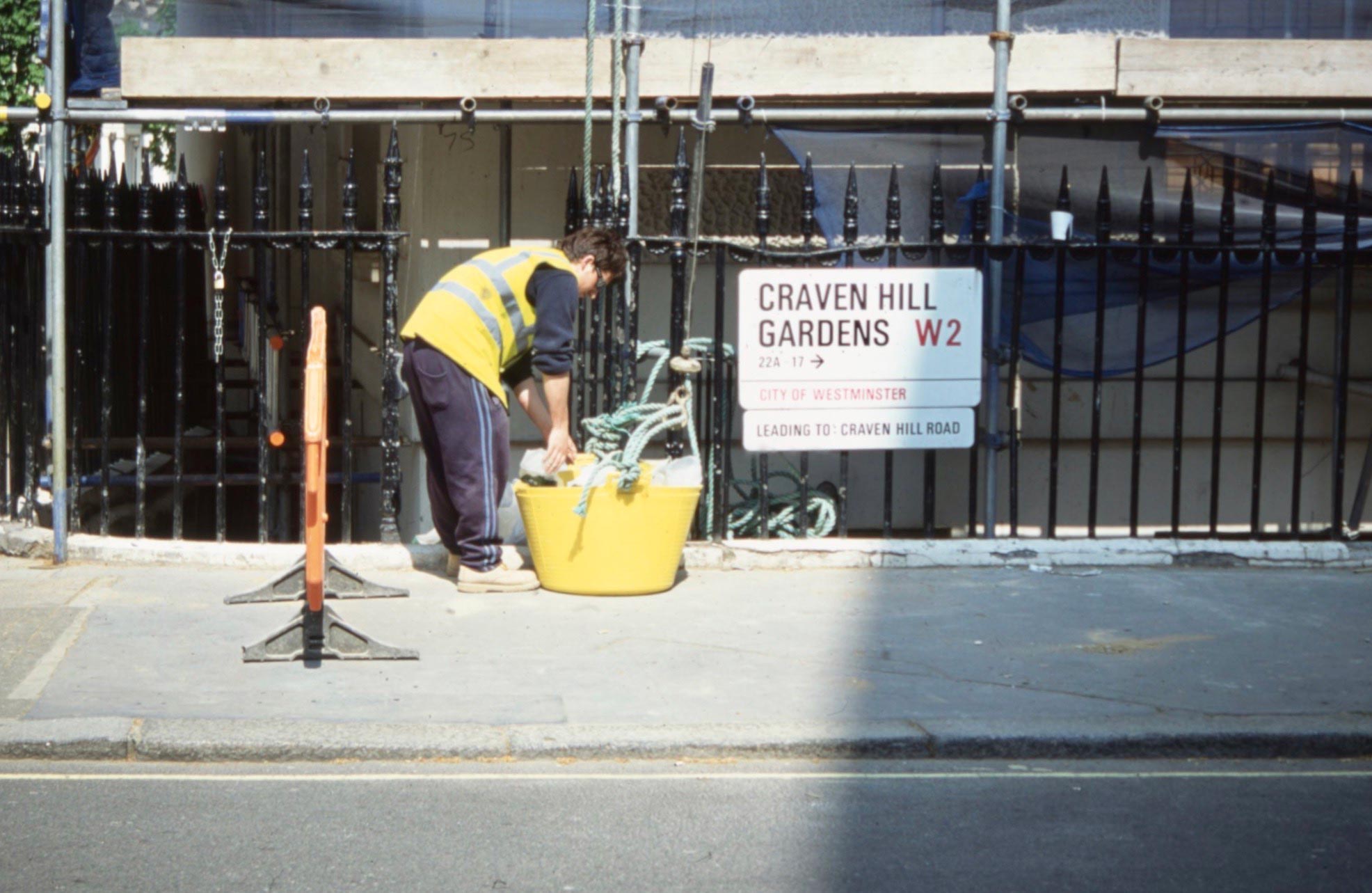
There are always building works going on somewhere in the capital. These were in Craven Hill Gardens W2, not far from my flat in Sutherland Place.

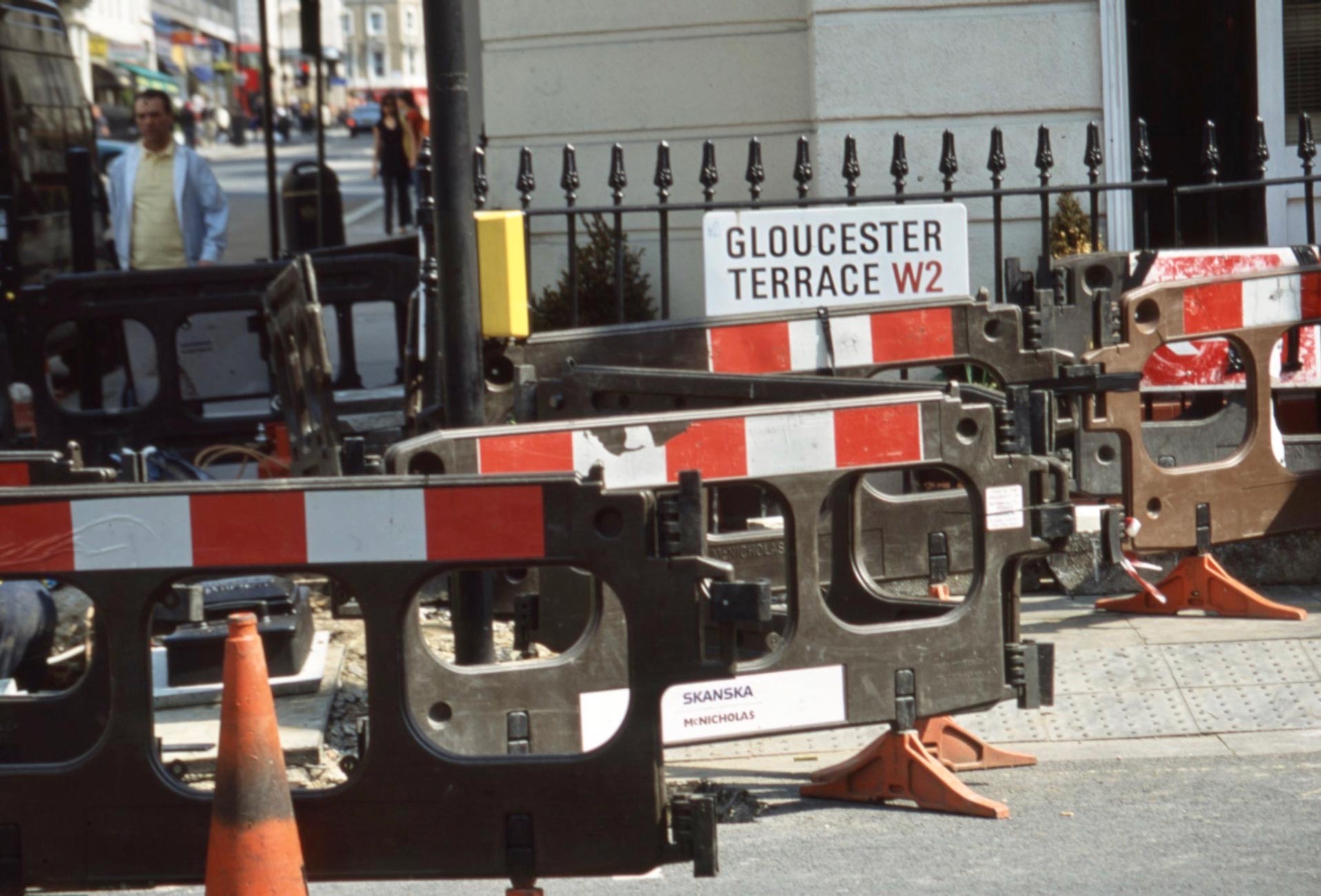
Similarly roadworks are ubiquitous, as in Gloucester Terrace.

Unfortunately I cannot decipher the street name, too far back in this typical W2 scene.

The area contains many Mews, such as Conduit,
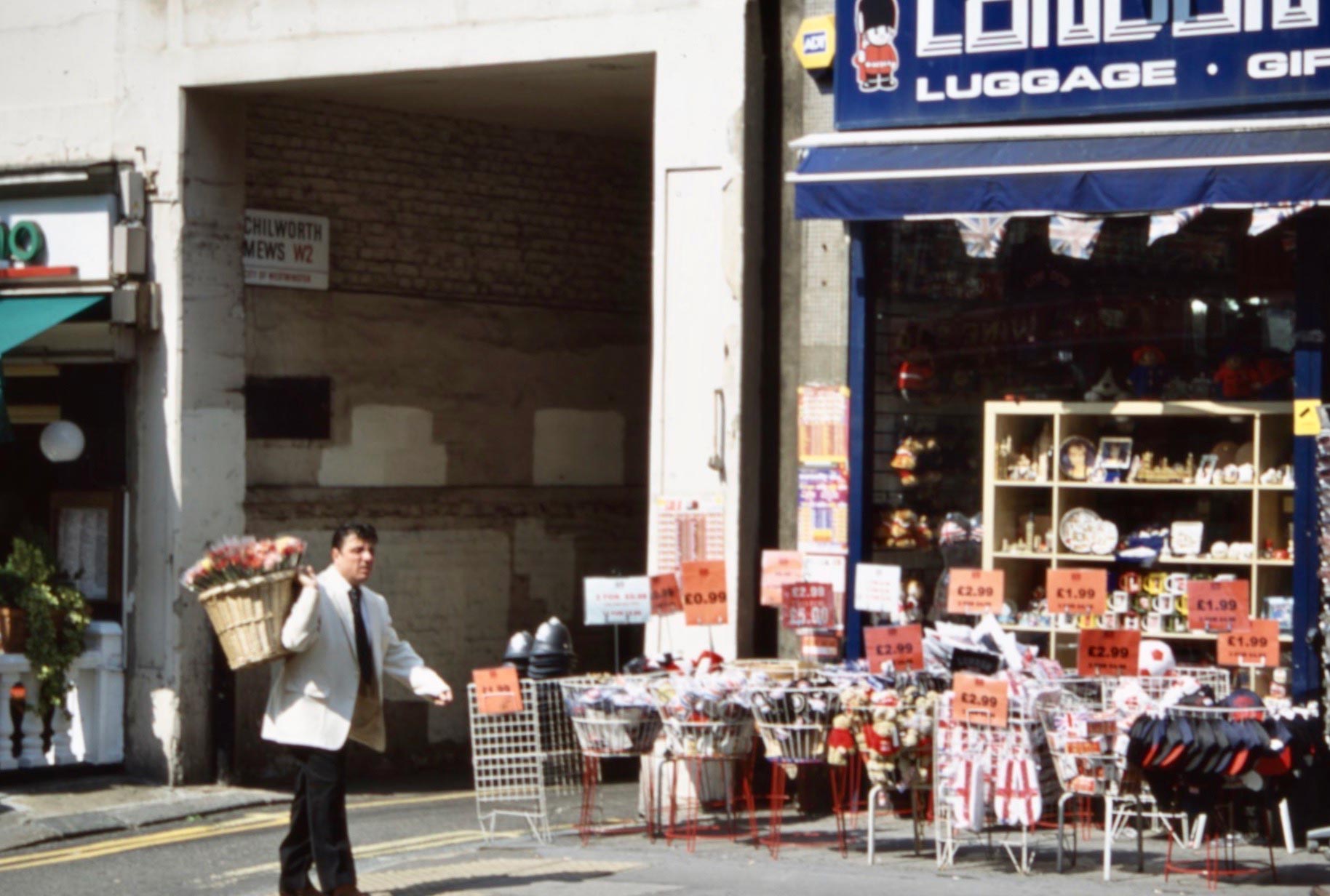
Chilworth,
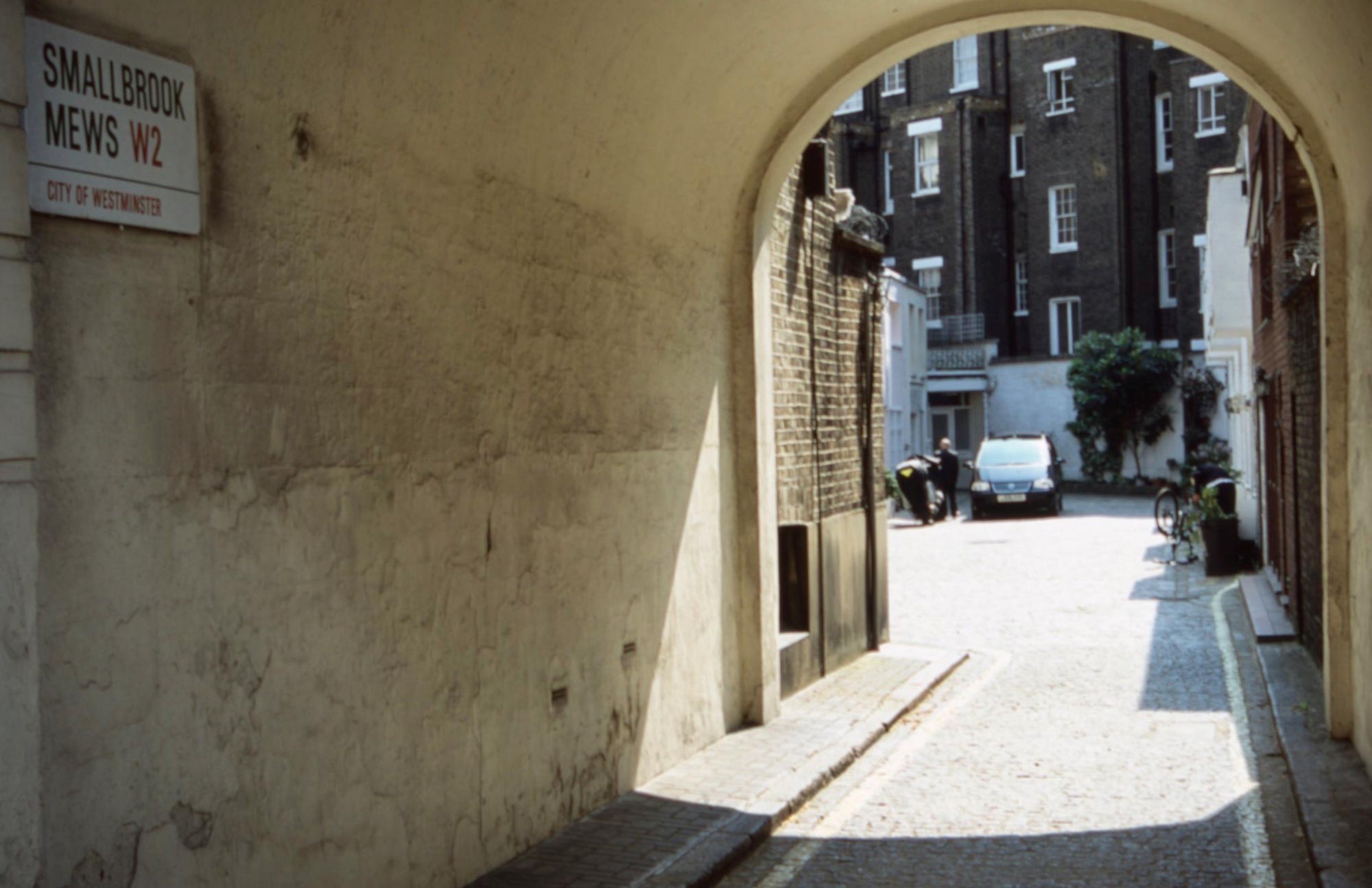
and Smallbrook.
As suggested in https://derrickjknight.com/2017/09/04/remembering-hyde-park-square/ a mews was a small yard containing stables which have, with one exception, now been converted into upmarket residences.
Right Move quotes current average prices for Conduit, £2,087,500 and Chilworth, £1,200,000.
For £3,500,000 you could splash out for a modernised four bedroomed property complete with roof terrace in Smallbrook.
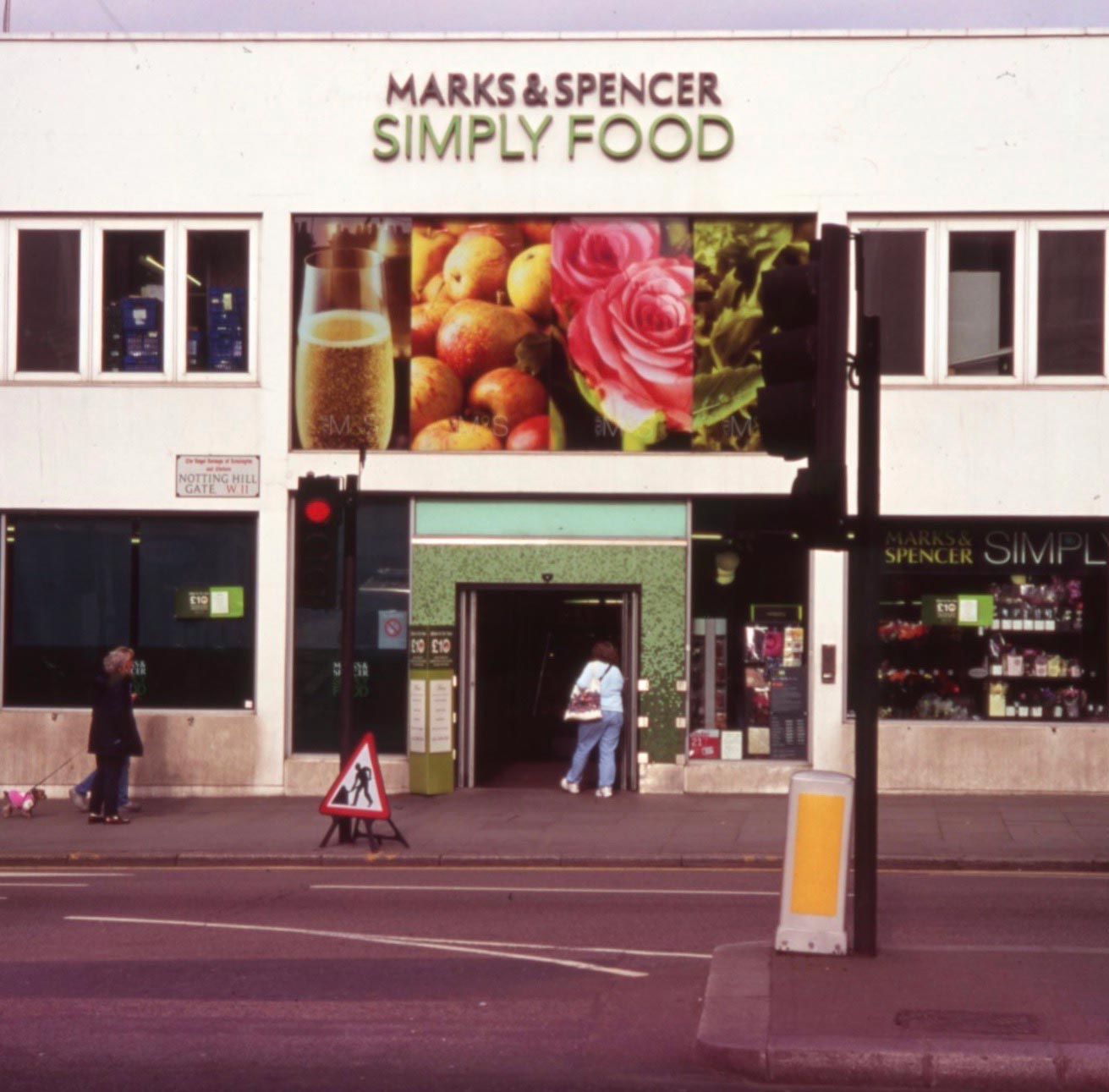
Marks & Spencer has a branch in Notting Hill Gate, W11.

Nearby, the Art Shop in Pembridge Road was my regular supplier of materials.
‘Notting Hill, an affluent district of West London, England,[1] in the Royal Borough of Kensington and Chelsea. Notting Hill is known for being a cosmopolitan and multicultural neighbourhood, hosting the annual Notting Hill Carnival and Portobello RoadMarket.[2] From around 1870, Notting Hill had an association with artists.[3]
For much of the 20th century, the large houses were subdivided into multi-occupancy rentals. Caribbean immigrants were drawn to the area in the 1950s, partly because of the cheap rents, but were exploited by slum landlords like Peter Rachman and also became the target of white Teddy Boys in the 1958 Notting Hill race riots.
Then known for its slum housing, in the early 21st century, after decades of gentrification, Notting Hill has a reputation as an affluent and fashionable area,[4] known for attractive terraces of large Victorian townhouses and high-end shopping and restaurants (particularly around Westbourne Grove and Clarendon Cross). A Daily Telegraph article in 2004 used the phrase “the Notting Hill Set“[5] to refer to a group of emerging Conservative politicians, such as David Cameron and George Osborne, who would become respectively Prime Minister and Chancellor of the Exchequer and were once based in Notting Hill. North Kensington is also home to the Grenfell Tower, which burnt down in 2017.’ (Wikipedia)
‘A turnpike gate was constructed at the foot of the hill on the main road from London to Uxbridge, now Oxford Street, Bayswater Road and Holland Park Avenue along this part of its route. The point at which the turnpike gate stood was known as Notting Hill Gate. The gate was there to stop people passing along the road without paying. The proceeds were applied towards the maintenance of this important road. The gate was removed in the 19th century and the high road was widened and straightened in the 1960s, involving the demolition of many buildings, the linking of two separate tube stations and the construction of two tower blocks.’ (Wikipedia)
I featured the Carnival in https://derrickjknight.com/2021/01/14/notting-hill-carnival/
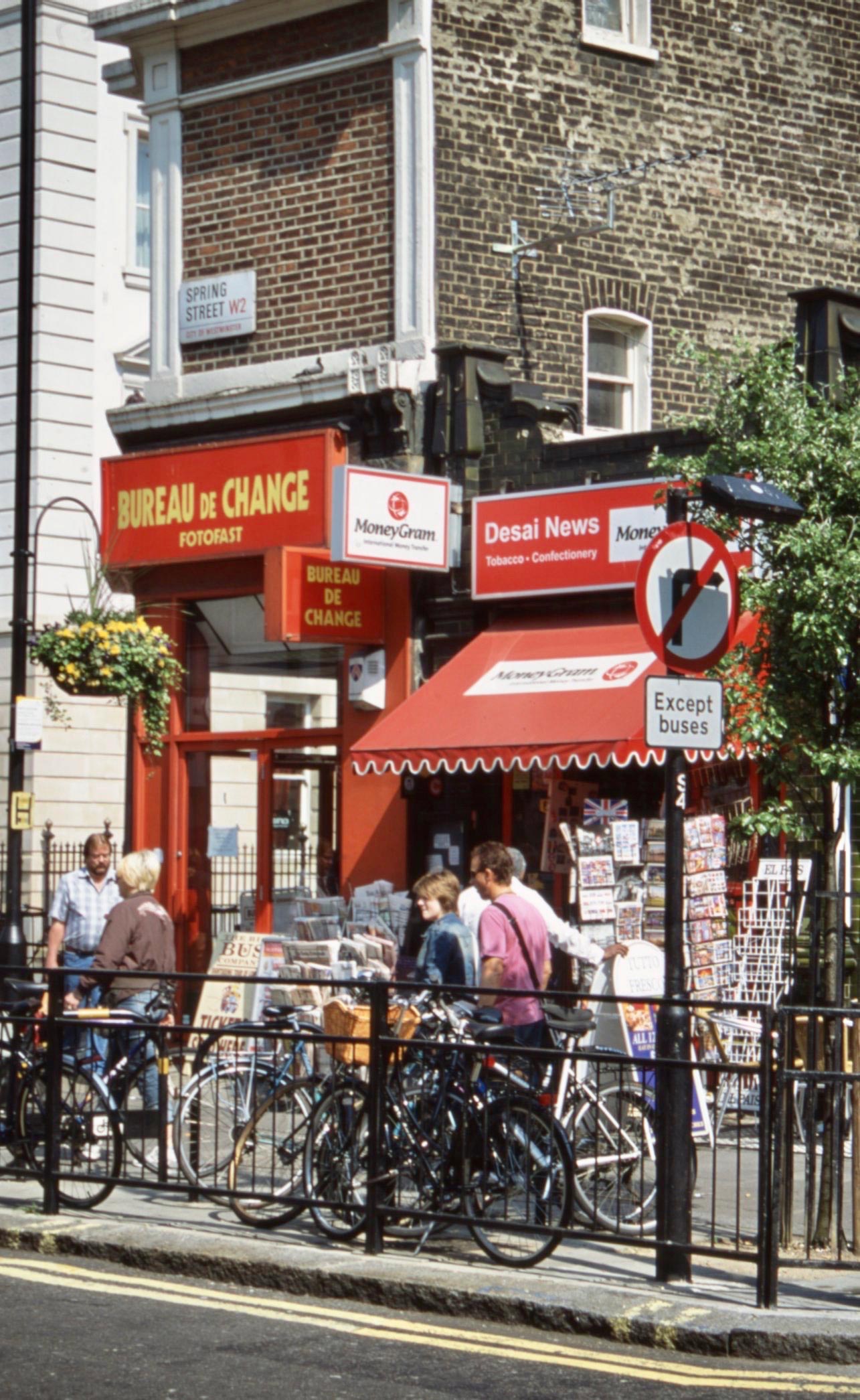
Spring Street W2 is in the area of Paddington known as Tyburnia, ‘a part of Paddington created to an 1824 masterplan by Samuel Pepys Cockerell to redevelop the historic lands of the Bishop of London, known as the Tyburn Estate, into a residential area to rival Belgravia.’ (Wikipedia).
Here is an extract from https://www.british-history.ac.uk/vch/middx/vol9/pp190-198#p1
‘Tyburnia
Tyburnia was a name used in the early 19th century for the south-eastern corner of the parish, the first part of the Paddington Estate to be built up. (fn. 1) It was adopted presumably because ‘Tyburn’ was already well known, as a reference to the gallows at Tyburn tree. (fn. 2) The old name of the execution site was itself misplaced since the Tyburn, teo or ‘boundary’ stream, (fn. 3) ran much farther east, from Hampstead across Marylebone to Oxford Street. The Marylebone manor of Lisson lay west of the stream, along Edgware Road, and that of Tyburn to the east. (fn. 4)Paddington’s Tyburnia, in the angle between Edgware and Bayswater roads, stretched westward from the former gallows to merge with Bayswater. In the 1870s the name was confined to a fashionable area, bounded on the west by Westbourne and Gloucester terraces, north of Lancaster Gate. (fn. 5) The area described below extends westward only to Eastbourne Terrace and the southern end of Westbourne Terrace (fn. 6) but northward to the industrial belt beyond Praed Street, as far as the canal basin. It covers Hyde Park ward and a southerly part of Church ward, as created in 1901, and also includes St. George’s burial ground. (fn. 7)
The execution site (fn. 8) was chosen presumably because there was a prominent group of trees at the parting of two main roads out of London. Some medieval references to ‘the elms’ may have been to those at Smithfield, but it was at Tyburn that William FitzOsbert was hanged in 1196 and at the elms there that Roger Mortimer, earl of March, died in 1330. From the 14th century many political executions took place at Tyburn, where the trees probably made way for temporary gallows before a permanent triangular frame was set up in 1571. The frame was depicted by Hogarth, (fn. 9) in whose day it was known as Tyburn tree and served as London’s chief place of public execution, where 21 victims could be hanged simultaneously. Often there were triumphant processions and huge crowds, an estimated 200,000 attending the death of Jack Sheppard in 1724. A grandstand on the west side of Edgware Road was sometimes used, (fn. 10) before and after the triangular frame was replaced by a movable gallows in 1759, until criticism led to the choice of a new site outside Newgate gaol in 1783.
The triangular gallows stood in the centre of the wide southern extremity of Edgware Road until the building of the Uxbridge road tollhouse in 1759. The approximate site has been marked by successive plaques: against the railings of Hyde Park, in 1909 in Edgware Road, and in 1964, after road widening, on a traffic island at the junction with Bayswater Road. The position of the later movable gallows was c. 50 yards farther north in Edgware Road and was thought in the 1870s to have been that of a house at the south-east corner of Connaught Square (formerly no. 49), (fn. 11) although several sites close by have been suggested.
Burials of corpses from Tyburn were recorded from 1689 and brought profit to the minister and churchwardens of Paddington in the late 17th and the 18th century, (fn. 12) when execution days came to be known as ‘Paddington fair’. (fn. 13) Remains were also buried under the scaffold and unearthed when the area came to be built up. Among them were the presumed bones of Oliver Cromwell and fellow regicides, whose posthumous consignment to a pit at the gallows’ foot in 1661 probably gave rise to William Blake’s allusion to ‘mournful ever-weeping Paddington’. (fn. 14)‘
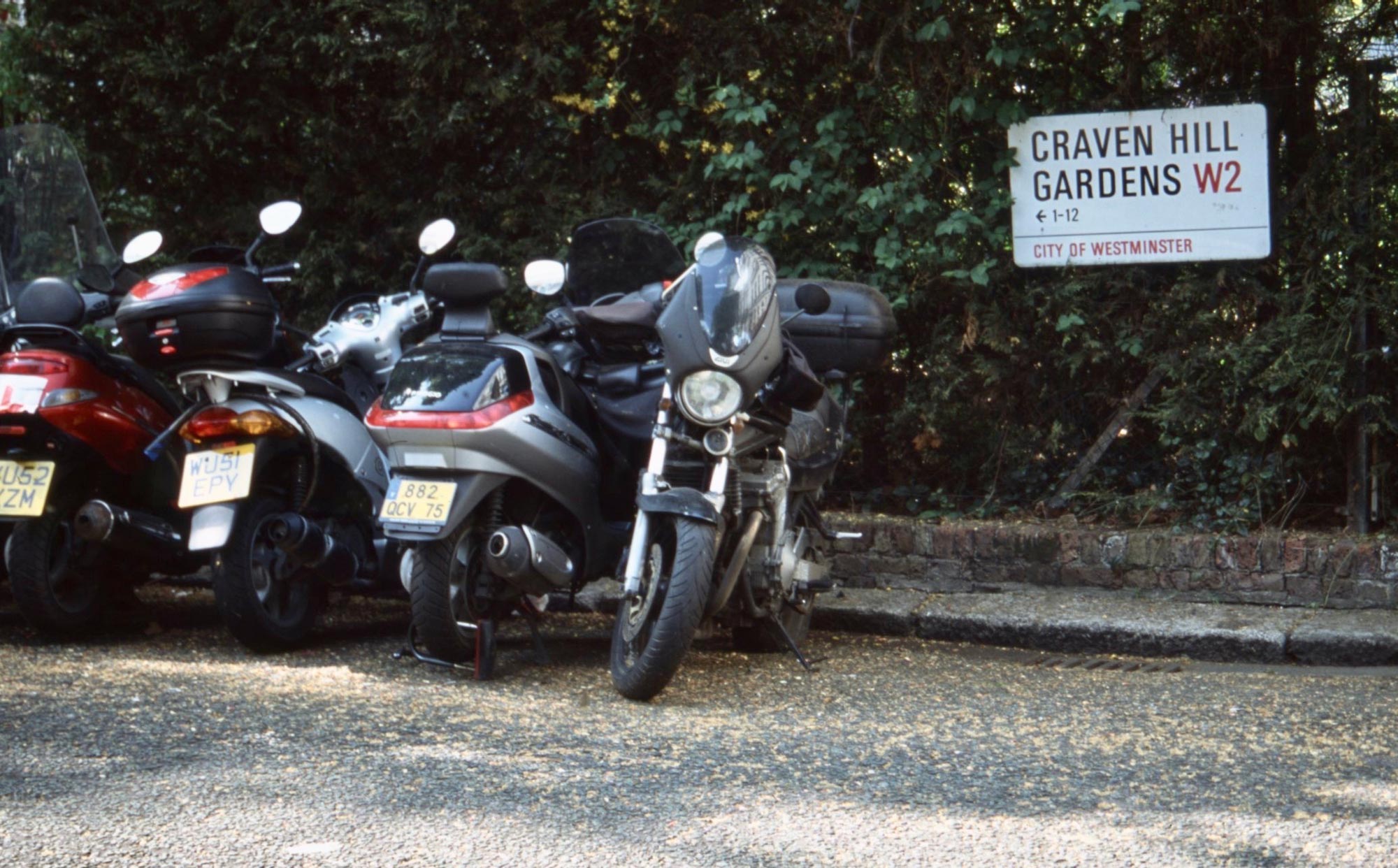
The Craven Hill Gardens W2 sign hangs on the railings of one of the two communal residential gardens typical of Victorian Bayswater estates.

The green hut in the centre of Kensington Park Road opposite Ladbroke Road W11 is explained in https://derrickjknight.com/2018/01/15/up-west/ which features another Cabmen’s Shelter.
Jackie received her vaccination invitation this afternoon and was able to make an appointment for 5th February.
This evening we dined on succulent roast pork; sage and onion stuffing; crisp potatoes, including the sweet variety, and well frosted parsnips, roasted in jalfrezi-flavoured oil; crunchy carrots and cauliflower; tender runner beans, and tasty gravy, with which Jackie drank Hoegaarden and I finished the Comté Tolosan Rouge.
I loved living in W2, such a vibrant and colourful area.
It is, Sheree. Thanks very much.
Those real estate prices are just crazy. I have enough money to buy an outdoor dunny to live in, think!
Where did Jackie acquire her cooking skills? Is it just from a few years of doing it, and a love of the craft?
Yes, Jackie has spent years at it, and does enjoy doing it. The prices are quite outrageous – a consequence of lots of people packed into small spaces. Thanks very much, Yvonne.
Some great social history in these pictures Derrick.
Thanks very much, Andrew
Interesting pictures from your past.
Thanks very much, Mrs W,
Your welcome.
When I went to London pre-pandemic in 2019, our group staying in Kensington. I’m a fan of the architecture and vibe of the area. Nice shots, Derrick. I appreciated learning a new word today. “Mew”.
Thanks very much, Cindy
Tyburnia has quite a history. I’ve never understood the attraction of public hangings. They were quite popular in the US for a time as well. *shudder*
Agreed. We had them for centuries, Liz. Thanks very much
You’re welcome, Derrick.
Wonderful photos, Derrick! Such interesting history. I love seeing the architecture.
The thought of the public hangings has always freaked me out. I will never understand the people showing up to watch, etc. 😮
I’m so glad Jackie will get her vaccination! YAY!!! 🙂
(((HUGS))) 🙂
PS…Now I’m thinking of Paddington Bear! 🙂
Thanks very much, Carolyn X
You’re welcome very much, Derrick!
🙂
You are a mine of information.
Thanks a lot, Tootlepedal
It’s been a while since I wandered that part of London. This really took me back.
Thanks very much, Gary
I always enjoy hitting the streets with you, Derrick. Nice shots and history today.
Thank you very much, Jill
Always love to see London in your photos, though I did resist the temptation to lose myself in the links tonight. Good to hear Jackie is getting her vaccination. As an aside on public hangings – I suppose you’ve already been told that you share a name with an executioner, but here is the link in case not.
https://en.wikipedia.org/wiki/Thomas_Derrick
An excellent addition, Quercus. I had forgotten about my namesake. I thought of you all the time I was putting this post together, because I know you like the series. Thanks very much
🙂 I is an excellent subject, and done well.
A great collection London suburbia Derrick… I could closely to relate to this piece..
“‘Notting Hill is an affluent district of West London, England,[1] in the Royal Borough of Kensington and Chelsea. Notting Hill is known for being a cosmopolitan and multicultural neighbourhood, hosting the annual Notting Hill Carnival” ……
And I have reworded this to represent my local area..
“The Ashbury area is an affluent district of West Geelong, located around Pakington Street, and is known for being a cosmopolitan and multicultural neighbourhood hosting the annual “Pako Festa” carnival”…..
🙂 such synchronicity, Ivor. Thanks very much
Not the same, but similar
I always love your London street pictures. The guy with the basket of flowers!!! Wow. And then when you add history or an anecdote it gilds the lily.
I’m pleased, Lisa. Thank you very much
A colorful and highly informative tour and a fascinating history of Tyburn, Derrick.
Thanks very much, Dolly
You are very welcome, Derrick.
It is interesting how you employ scanning as a time machine. I was deeply engrossed in the history, sociology and topography of parts of London. Some of those prices made my eyes and nose water, not that I ever had plans to buy a property in London. The Tyburnian history harks back to the dark pages of human past. But history has a notorious tendency of revisiting its victims, and its naked dance is perpetuating in the Middle East and Afghanistan even today.
Thanks very much, Uma. Your comments are so telling.
I enjoyed the virtual tour, Derrick. Tyburnia must be full of wandering ghosts. I wonder if the area has any stories of such things.
Thanks very much, Lavinia. There is quite a bit on Google, but not much very compelling. There is, however, a closed convent where nuns still pray for the souls of the Catholic martyrs: https://lookup.london/tyburn-tree-hidden-history-marble-arch/
Gruesome history! We have similar horrible stories here. Wonderful that Jackie will soon be getting a vaccine. Hope Clif will get his soon.
Thanks very much, Laurie
So interesting to learn about the history of that beautiful part of London. How many different chapters the occupants of those London terraces have written for each house…
Very well put, Emma. Thanks you very much
Fascinating pictures, Derrick. Thanks for scanning them for us.
Thanks very much for your appreciation, GP
Quite a contrast between London and where you live now. I knew about Tyburn, but not Tyburnia.
That is great news that Jackie has an appointment for her vaccination–and soon!
Thank you very much, Merril
You’re welcome.
Thanks for the memories Derrick. I lived in a flat in Pembridge Crescent for a year in 1978.
I’m pleased to have stirred them, Val. Thanks to you, too
lovely collection of street shots, Derrick! they tell a lot of stories. 🙂
They do, Lola. Thanks very much
Ik wil het allemaal lezen en heb van u geleerd, om wat losser in de pols te fotograferen: Laat alles zien! De hele Kinkerstraat, de markt, de Hema en weer terug naar de Hallen.
De Hallen zou Derrick geweldig vinden en maak er meer dan 10 foto’s van, van links naar rechts & van alles wat er is te bestellen … Ja .. , doen we …
Maar, wat ik wilde vertellen is, dat Godfried Bomans een van de meest gelezen auteurs van Nederland was … Was met zijn kop niet van de buis te rammen en hij was in Den Haag geboren, zijn vader deed iets deftigs in het parlement, op 2 maart 1913, overleed aan een hartaanval in 1971, dat is toch een leeftijd van niks, zou ik zeggen … , 58 jaar jong.
Kutwijf is niet dood te knuppelen en fietst rustig naar de 80, maar uw conditie … , die kan ik niet bijhouden …
Godfried Bomans werd in alle talen van de hele wereld vertaald, dus vooral in het Engels … In Amsterdam wordt ook meer Engels gesproken, dan gewoon Hollands … Ze willen het niet leren, hoor … Wij leren wel braaf Engels … , dacht toch van niet … Waar waren we? Ik zou zeggen: googelen http://www.Godfried Bomans.nl/books/gedichten enz. …
* http://www.friedabblog.wordpress.com * Amsterdam * 31 – 1 – 2021 *
Heel erg bedankt, Frieda
Lots of interesting material here, Derrick! This is a post I’ll be coming back too. So Glad Jackie got her vaccine appointment. Sher and I are hoping we’ll be able to get appointments made next week. Probably will be 2 to 3 weeks out before we’ll actually get the shots.
Good luck to you both. Thanks very much, Maj
This was so interesting Derrick.
The other day I read a post from another blogger, a southerner, who was complaining about the North, South divide. He was objecting to money being invested in high speed transport for the North when housing is cheaper up here. In his opinion the government should be investing in the south and helping southerners to buy houses and not investing in speedier transport for the north. I’m not sure how that would work.
I think I’ll pass on that, Sue. When we moved from London to Newark in 1987 one of my calculations included that, at, I think, £2500 a year, an annual season ticket to Kings Cross was just about affordable. British Rail then took the decision that long distance commuters should pay equitable rates with shorter ones. They hiked up the cost by 5% per annum for five years. Thanks very much
Wow! Crazy crazy prices ?Great memories filled with history!
Crazy, indeed, Ribana. Thank you very much
Very interesting post Derrick! Glad Jackie got her time for her vaccine shot! How about you??
I had mine a couple of weeks ago. You must have missed it 🙂
I think so… I am not scheduled till April!!
Stay safe until then – and beyond
Yes, I will try… thank you!
I’m pleased that Jackie will be having her jab later in the week.
Some gruesome history of London there, Derrick.
Thanks very much, Helen
Such a walkabout and historical notes–a pleasure. Glad Jackie will be up soon…you are next or have you completed vaccinations? Wondering how the any side effects seem. Still waiting over here…slow, too slow a rollout.
Jackie has her first next week; we both have our second in April. I hope they speed up with yours. Thanks very much, Cynthia
Good. Here’s hoping.
I’ve popped into the M&S in Notting Hill Gate several times mate. I love meandering around the streets of London.
Thanks a lot, John
Informative and interesting to learn about the history of Tyburnia, London. Amazing pictures
Thank you very much, Monica